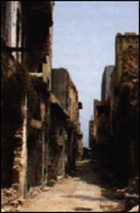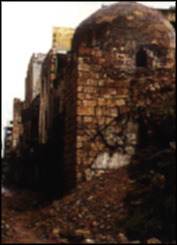
| |

 If possible, the physical traces of the past are to be preserved rather than
disturbed. The small Mamluk monument and sanctuary on Beirut's main east-
west thoroughfare will stand in the city of the future as a tangible witness to
Beirut 500 years ago. Even in its post-war state it reminds us of the intimate and
functional composition of Islamic architecture based on infinite variations of
arches and domes, enclosing shady courtyards with fountains and birds, and
interlaced with gardens, public or planted spaces where trees often rose high
above the domes and terraced roofs.
If possible, the physical traces of the past are to be preserved rather than
disturbed. The small Mamluk monument and sanctuary on Beirut's main east-
west thoroughfare will stand in the city of the future as a tangible witness to
Beirut 500 years ago. Even in its post-war state it reminds us of the intimate and
functional composition of Islamic architecture based on infinite variations of
arches and domes, enclosing shady courtyards with fountains and birds, and
interlaced with gardens, public or planted spaces where trees often rose high
above the domes and terraced roofs.
Even late Ottoman Lebanese houses - their luscious gardens still clinging to them - are today rare and often delapidated islands between concrete buildings or ruins. Their preservation, restoration and upkeep demand huge funds and expertise at a time when the country's reconstruction and development are more urgent priorities. In 1992, the small Mamluk monument on Souk Tawile narrowly escaped bulldozer destruction, by miraculous intervention according to popular accounts. Originally a private place of learning and prayer, Beirut's unique Mamluk zawiya has the potential to become a sanctuary of recollection and meditation at the center of tomorrow's bustling city. IJntil the war, Beirutis, at prayer time, took refuge in the small memorial mosque of Imam 'Ouza'i which faced the zawiya of Ibn 'Iraq on the opposite side of Souk Tawile. Perhaps the memory of two important Muslim scholars associated with the surviving physical space and monument where they once lived and taught, could inspire Beirutis to reflect upon the past they share.
| |
 al@mashriq 960118/960118 |

 With the pemlission of the waqf authorities and in collaboration with the Directorate
General of Antiquities, the archaeological team engaged in tediscovering the original
context of the Mamluk sanctuary will propose an accurate restoration model of the
building. This is part of the task to evaluate the importance of the
physical traces of the past, and reconstitute them visually. The 1994
urban excavations revealed that the Mamluk building stood in an artisans'
quarter on Beirut's main east-west street, providing for the medieval
town to the south, and also connected to the harbor by another
stret t, leading straight north, probably through a green planted space.
With the pemlission of the waqf authorities and in collaboration with the Directorate
General of Antiquities, the archaeological team engaged in tediscovering the original
context of the Mamluk sanctuary will propose an accurate restoration model of the
building. This is part of the task to evaluate the importance of the
physical traces of the past, and reconstitute them visually. The 1994
urban excavations revealed that the Mamluk building stood in an artisans'
quarter on Beirut's main east-west street, providing for the medieval
town to the south, and also connected to the harbor by another
stret t, leading straight north, probably through a green planted space.